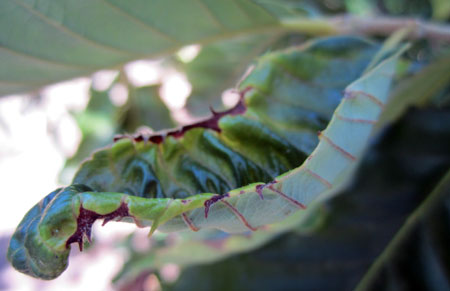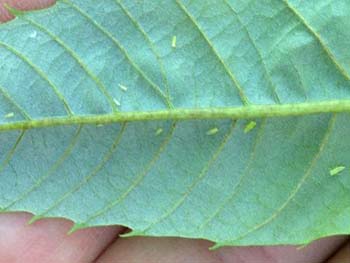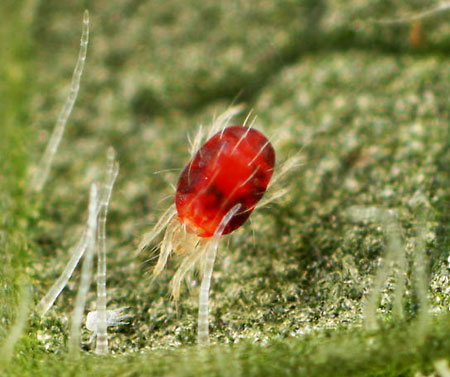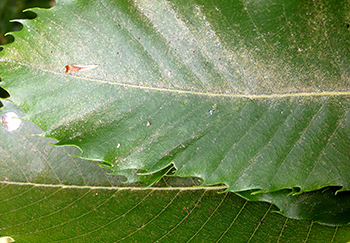Michigan chestnut scouting report – May 5, 2017
We will be tracking chestnut development, management and pest pressure this season. Subscribe to our newsletter to ensure you don’t miss any important information.

Growers are working on getting irrigation systems back online, weed sprays and fertilizer applications have been completed in many locations. Much of the state has been experiencing well-above average precipitation (roughly double), making field work difficult. Degree-day accumulation is slightly ahead this season when compared with the last five years.
Growth stage is variable around the state, from budbreak to 1-inch green tip. As growers look ahead to the month of May, mites and potato leafhoppers should be on the forefront of their scouting efforts.
Don’t forget to subscribe to Michigan State University Extension’s Fruit and Nuts Production newsletter to ensure you don’t miss any important information.
Potato leafhoppers
Like many plants, chestnuts are sensitive to the saliva of potato leafhopper, which is injected by the insect while feeding. Damage to leaf tissue can cause reduced photosynthesis, which can impact production and quality. Most injury occurs on new tissue on shoot terminals with potato leafhopper feeding near the edges of the leaves using piercing-sucking mouthparts. Symptoms of feeding appear as whitish dots arranged in triangular shapes near the edges. Heavily damaged leaves are cupped with necrotic and chlorotic edges and eventually fall from the tree. Severely infested shoots produce small, bunched leaves with reduced photosynthetic capacity.

Potato leafhopper feeding damage to chestnut causing leaf cupping and necrotic margins. Image courtesy of Erin Lizotte, MSU Extension.
Adult leafhoppers are pale to bright green and about 0.125 inch long. Adults are easily noticeable, jumping, flying or running when agitated. The nymphs (immature leafhoppers) are pale green and have no wings, but are very similar in form to the adults. Potato leafhoppers move in all directions when disturbed, unlike some leafhoppers that have a distinct pattern of movement. The potato leafhopper can’t survive Michigan’s winter and survives in the Gulf States until adults migrate north in the spring on storm systems.


Potato leafhopper adults and nymphs at various stages of development on the underside of chestnut leaves. Images courtesy of Erin Lizotte, MSU Extension.
Scouting should be performed weekly as soon as leaf tissue is present to ensure detection early and prevent injury. More frequent spot checks should be done following rain storms, which carry the first populations north and can cause re-infestation later in the season. For every acre of orchard, select five trees to examine and inspect the leaves on three shoots per tree (a total of 15 shoots per acre). The easiest way to observe potato leafhoppers is by flipping the shoots or leaves over and looking for adults and nymphs on the underside of leaves. Pay special attention to succulent new leaves on the terminals of branches. For more information on insecticides available for the treatment of potato leafhopper, refer to the “Michigan Chestnut Management Guide, 2017.”
European red mites
Chestnut trees are susceptible to feeding damage from European red mite. Affected leaves appear mottled, stippled or bronzed and become brittle, leading to early defoliation and reduced photosynthetic activity. Reduced photosynthesis can lead to reduced nut size and return crop load in subsequent years as well as increased sensitivity to winter injury.
At this time, no treatment thresholds are established for mites in chestnut, but evidence from crops like cherry indicate some level of feeding is likely tolerable and higher populations can be tolerated as the season progresses through summer. European red mite appears to be the more prevalent mite species for chestnut producers, but growers should keep an eye out for twospotted spider mites as well.
European red mites overwinter as eggs in bark crevices and bud scales. Eggs are small spheres, about the size of the head of a pin with a single stipe or hair that protrudes from the top (this is not always visible). Eggs can be viewed with a hand lens or the naked eye once you have established what you are looking for. Growers can scout for overwintering eggs and early nymph activity in spring to assess population levels in the coming season.
As temperatures warm, overwintering eggs hatch and nymphs move onto the emerging leaves and start feeding. Adult European red are red and have hairs that give them a spikey appearance. Adult and nymph feeding occurs primarily on the upper surface of the leaves. This first generation is the slowest of the season and typically takes a full three weeks to develop and reproduce. This slow development is due to the direct link between temperature and mite development. Summer generations, favored by the hot and dry weather, are able to complete their lifecycles much faster with as little as 10 days between generations under ideal conditions.

Adult European red mite feeding on leaves (left/top), and bronzing or “dusty” leaf surface caused by European red mite activity (right/bottom). Images courtesy of Scott Justis (left) and Erin Lizotte, MSU Extension (right).
When scouting, remember that not all mites are bad. Consider documenting the levels of predacious mites in your orchard. If healthy populations of mite predators exist, they will continue to feed on plant parasitic eggs and nymphs and can be an effective component of your mite management program. The three most important predaceous mites are Amblyseius fallacis (Phytoseiidae), Agistemus fleschneri (Stigmaeidae) and Zetzellia mali (Stigmaeidae). See Michigan State University Extension’s “A Pocket Guide for IPM Scouting in Michigan Apples” E02720 for pictures. Predaceous mites are larger than adult European red mites and twospotted spider mites, but they can be seen with a hand lens and typically move very quickly across leaf surfaces.
Mite control starts with monitoring early in the spring looking for the overwintering European red mite eggs or twospotted spider mite adults and assessing the mite pressure. Ideally, growers will be using limited insecticides with miticidal activity in their season-long programs as that protects their beneficial mite populations and provides for natural control. If infestations are highly localized on a small set of trees, spot treatments should be considered.
If pest mite populations are high enough to require control, dormant superior oil applications are an effective method of treatment. Ensuring adequate coverage is critical to attaining optimal control on problem sites as oil alone acts to smother mites and eggs. If you are applying an oil with an additional insecticidal property, such as those containing the neem extract azadirachtin, coverage is still critical as many are insect growth regulators and have antifeedant properties. Oil application comes with a risk of phytotoxicity, particularly as green tissue emerges. It is recommended growers do a small test spray if they have not used dormant oils in the past. Keep in mind too that different cultivars may have different sensitivities and proceed with caution.
Severely stressed trees should never be sprayed with oil and remember that temperature and humidity also play a role in the risk of phytotoxicity. Temperatures above 80 degrees Fahrenheit and slow drying time (high humidity) increase the chance of damage. Oil also has some potential compatibility issues growers should be aware of including Captan and sulfur.
Lastly, oil should be applied within a 48-hour window prior to and following freezing temperatures due to decreased efficacy and potential plant damage. Read and follow all label directions carefully to minimize the risk of spray damage.
For more information on pesticides to control mites, refer to “Michigan Chestnut Management Guide, 2017.”
This material is based upon work supported by the National Institute of Food and Agriculture, U.S. Department of Agriculture, under Agreement No. 2015-09785. Any opinions, findings, conclusions, or recommendations expressed in this publication are those of the author(s) and do not necessarily reflect the view of the U.S. Department of Agriculture.



 Print
Print Email
Email




